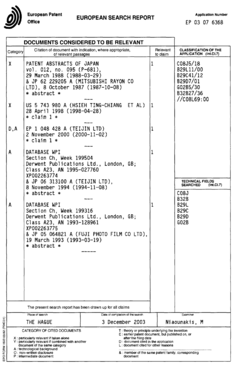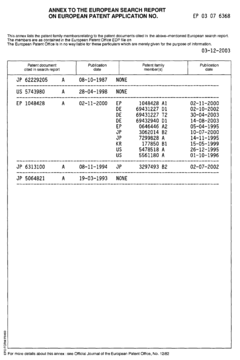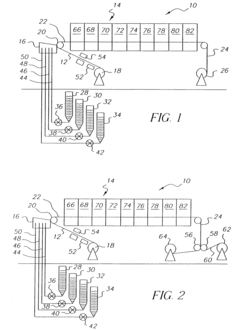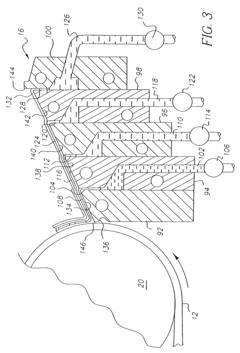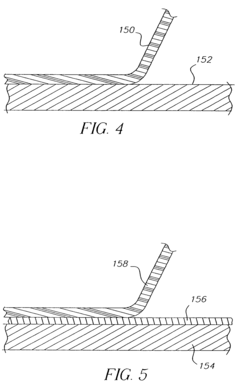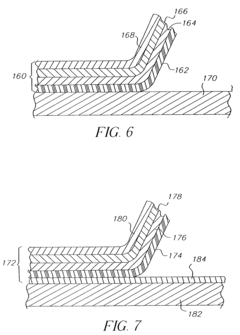How to Innovate Polycarbonate Film Applications?
JUL 1, 20259 MIN READ
Generate Your Research Report Instantly with AI Agent
Patsnap Eureka helps you evaluate technical feasibility & market potential.
Polycarbonate Film Evolution and Objectives
Polycarbonate film has undergone significant evolution since its introduction in the 1960s. Initially developed as a durable, transparent material for electrical insulation, it quickly found applications in various industries due to its unique combination of properties. The film's journey began with basic applications in electrical and electronic components, gradually expanding into more sophisticated uses in automotive, aerospace, and consumer electronics sectors.
Throughout the 1970s and 1980s, advancements in manufacturing processes led to improvements in the film's optical clarity, impact resistance, and dimensional stability. This period saw the emergence of polycarbonate film as a preferred material for display screens and protective overlays. The 1990s marked a turning point with the introduction of advanced coating technologies, enhancing the film's scratch resistance and UV protection capabilities, thereby opening up new avenues in outdoor applications and durable goods.
The early 2000s witnessed a surge in demand for thinner, more flexible polycarbonate films, driven by the miniaturization trend in electronics. Concurrently, environmental concerns began to shape the industry, leading to the development of bio-based and recyclable polycarbonate film variants. This eco-friendly focus continues to be a significant driver of innovation in the field.
Recent years have seen a focus on enhancing the functional properties of polycarbonate films. Developments in nanotechnology have led to the creation of films with improved barrier properties, antimicrobial characteristics, and even self-healing capabilities. The integration of polycarbonate films with other materials and technologies, such as flexible electronics and smart coatings, represents the cutting edge of current research and development efforts.
Looking ahead, the objectives for polycarbonate film innovation are multifaceted. There is a strong push towards developing films with enhanced sustainability profiles, including improved recyclability and reduced environmental impact throughout the product lifecycle. Another key goal is to expand the film's functionality, exploring possibilities such as embedded sensors, color-changing properties, and enhanced energy efficiency in various applications.
The industry also aims to improve the film's performance in extreme conditions, targeting applications in aerospace, deep-sea exploration, and other challenging environments. Additionally, there is a growing interest in developing polycarbonate films that can serve as platforms for advanced manufacturing techniques, such as 3D printing and flexible electronics production.
As we move forward, the overarching objective is to position polycarbonate film as a versatile, high-performance material capable of meeting the evolving demands of emerging technologies and sustainable practices. This involves not only enhancing its inherent properties but also exploring novel applications that leverage its unique characteristics in innovative ways.
Throughout the 1970s and 1980s, advancements in manufacturing processes led to improvements in the film's optical clarity, impact resistance, and dimensional stability. This period saw the emergence of polycarbonate film as a preferred material for display screens and protective overlays. The 1990s marked a turning point with the introduction of advanced coating technologies, enhancing the film's scratch resistance and UV protection capabilities, thereby opening up new avenues in outdoor applications and durable goods.
The early 2000s witnessed a surge in demand for thinner, more flexible polycarbonate films, driven by the miniaturization trend in electronics. Concurrently, environmental concerns began to shape the industry, leading to the development of bio-based and recyclable polycarbonate film variants. This eco-friendly focus continues to be a significant driver of innovation in the field.
Recent years have seen a focus on enhancing the functional properties of polycarbonate films. Developments in nanotechnology have led to the creation of films with improved barrier properties, antimicrobial characteristics, and even self-healing capabilities. The integration of polycarbonate films with other materials and technologies, such as flexible electronics and smart coatings, represents the cutting edge of current research and development efforts.
Looking ahead, the objectives for polycarbonate film innovation are multifaceted. There is a strong push towards developing films with enhanced sustainability profiles, including improved recyclability and reduced environmental impact throughout the product lifecycle. Another key goal is to expand the film's functionality, exploring possibilities such as embedded sensors, color-changing properties, and enhanced energy efficiency in various applications.
The industry also aims to improve the film's performance in extreme conditions, targeting applications in aerospace, deep-sea exploration, and other challenging environments. Additionally, there is a growing interest in developing polycarbonate films that can serve as platforms for advanced manufacturing techniques, such as 3D printing and flexible electronics production.
As we move forward, the overarching objective is to position polycarbonate film as a versatile, high-performance material capable of meeting the evolving demands of emerging technologies and sustainable practices. This involves not only enhancing its inherent properties but also exploring novel applications that leverage its unique characteristics in innovative ways.
Market Demand Analysis for PC Film Applications
The global market for polycarbonate (PC) films has been experiencing steady growth, driven by increasing demand across various industries. The versatility and unique properties of PC films make them attractive for a wide range of applications, from electronics to automotive and packaging sectors.
In the electronics industry, PC films are witnessing significant demand due to their use in display screens, touch panels, and flexible printed circuits. The growing consumer electronics market, particularly smartphones and tablets, is a key driver for PC film applications. As devices become thinner and more flexible, the demand for high-performance PC films is expected to rise further.
The automotive sector represents another substantial market for PC films. These films are used in interior and exterior components, such as instrument panels, lighting systems, and decorative trims. The trend towards lightweight vehicles and improved fuel efficiency is boosting the adoption of PC films as a replacement for traditional materials.
Packaging is an emerging application area for PC films, especially in the food and beverage industry. The films' excellent barrier properties, transparency, and durability make them suitable for high-performance packaging solutions. As consumers demand more sustainable and recyclable packaging options, PC films are gaining traction as an alternative to conventional materials.
The medical and healthcare sector is also contributing to the growth of PC film applications. These films are used in medical devices, diagnostic equipment, and pharmaceutical packaging due to their biocompatibility and sterilization resistance. The ongoing advancements in healthcare technology and the increasing focus on infection control are expected to drive further demand in this sector.
In the construction industry, PC films are finding applications in architectural glazing, roofing, and interior design elements. The films' UV resistance, impact strength, and thermal insulation properties make them attractive for both residential and commercial buildings.
Geographically, Asia-Pacific is the largest market for PC films, followed by North America and Europe. The rapid industrialization and urbanization in emerging economies, particularly China and India, are fueling the demand for PC films across various end-use industries.
The market demand for PC films is also influenced by technological advancements and innovation in film manufacturing processes. Developments in multi-layer film technology, surface treatments, and additives are expanding the potential applications of PC films, opening up new market opportunities.
However, the PC film market faces challenges from environmental concerns and competition from alternative materials. The industry is responding by focusing on recyclable and bio-based PC films, aligning with the growing emphasis on sustainability and circular economy principles.
In the electronics industry, PC films are witnessing significant demand due to their use in display screens, touch panels, and flexible printed circuits. The growing consumer electronics market, particularly smartphones and tablets, is a key driver for PC film applications. As devices become thinner and more flexible, the demand for high-performance PC films is expected to rise further.
The automotive sector represents another substantial market for PC films. These films are used in interior and exterior components, such as instrument panels, lighting systems, and decorative trims. The trend towards lightweight vehicles and improved fuel efficiency is boosting the adoption of PC films as a replacement for traditional materials.
Packaging is an emerging application area for PC films, especially in the food and beverage industry. The films' excellent barrier properties, transparency, and durability make them suitable for high-performance packaging solutions. As consumers demand more sustainable and recyclable packaging options, PC films are gaining traction as an alternative to conventional materials.
The medical and healthcare sector is also contributing to the growth of PC film applications. These films are used in medical devices, diagnostic equipment, and pharmaceutical packaging due to their biocompatibility and sterilization resistance. The ongoing advancements in healthcare technology and the increasing focus on infection control are expected to drive further demand in this sector.
In the construction industry, PC films are finding applications in architectural glazing, roofing, and interior design elements. The films' UV resistance, impact strength, and thermal insulation properties make them attractive for both residential and commercial buildings.
Geographically, Asia-Pacific is the largest market for PC films, followed by North America and Europe. The rapid industrialization and urbanization in emerging economies, particularly China and India, are fueling the demand for PC films across various end-use industries.
The market demand for PC films is also influenced by technological advancements and innovation in film manufacturing processes. Developments in multi-layer film technology, surface treatments, and additives are expanding the potential applications of PC films, opening up new market opportunities.
However, the PC film market faces challenges from environmental concerns and competition from alternative materials. The industry is responding by focusing on recyclable and bio-based PC films, aligning with the growing emphasis on sustainability and circular economy principles.
Current Challenges in PC Film Technology
Polycarbonate (PC) film technology, despite its widespread applications, faces several significant challenges that hinder its further development and innovation. One of the primary issues is the material's inherent brittleness, which limits its use in applications requiring high flexibility or impact resistance. This characteristic often leads to cracking or shattering under stress, particularly in thin film formats.
Another major challenge lies in the film's susceptibility to environmental factors. PC films are prone to degradation when exposed to UV radiation, leading to yellowing and loss of optical clarity over time. This limitation is particularly problematic for outdoor applications or products that require long-term transparency and aesthetic appeal.
The manufacturing process of PC films also presents challenges. Achieving uniform thickness and surface quality across large areas remains difficult, especially for ultra-thin films. This inconsistency can lead to optical distortions and performance variations in the final product, affecting applications in displays, optical devices, and protective coatings.
Chemical resistance is another area where PC films fall short. They are vulnerable to certain solvents and chemicals, which can cause crazing, cracking, or dissolution of the film. This sensitivity restricts their use in harsh chemical environments and limits cleaning options for PC film-based products.
Thermal stability is a further concern for PC films. While they offer good heat resistance compared to some plastics, they can still deform or lose their optical properties at elevated temperatures. This thermal limitation narrows the range of potential applications, particularly in high-temperature environments or processes.
The recyclability of PC films also poses a challenge. While polycarbonate is theoretically recyclable, the presence of additives, coatings, and contaminants in PC films often complicates the recycling process. This issue is becoming increasingly important as environmental regulations and sustainability concerns grow more stringent.
Lastly, the cost of producing high-quality PC films remains relatively high compared to some alternative materials. This economic factor can be a significant barrier to adoption in price-sensitive markets or applications where large quantities of film are required.
Addressing these challenges is crucial for expanding the application range of PC films and driving innovation in this field. Overcoming these limitations could open up new markets and possibilities for PC film technology, from advanced electronics to sustainable packaging solutions.
Another major challenge lies in the film's susceptibility to environmental factors. PC films are prone to degradation when exposed to UV radiation, leading to yellowing and loss of optical clarity over time. This limitation is particularly problematic for outdoor applications or products that require long-term transparency and aesthetic appeal.
The manufacturing process of PC films also presents challenges. Achieving uniform thickness and surface quality across large areas remains difficult, especially for ultra-thin films. This inconsistency can lead to optical distortions and performance variations in the final product, affecting applications in displays, optical devices, and protective coatings.
Chemical resistance is another area where PC films fall short. They are vulnerable to certain solvents and chemicals, which can cause crazing, cracking, or dissolution of the film. This sensitivity restricts their use in harsh chemical environments and limits cleaning options for PC film-based products.
Thermal stability is a further concern for PC films. While they offer good heat resistance compared to some plastics, they can still deform or lose their optical properties at elevated temperatures. This thermal limitation narrows the range of potential applications, particularly in high-temperature environments or processes.
The recyclability of PC films also poses a challenge. While polycarbonate is theoretically recyclable, the presence of additives, coatings, and contaminants in PC films often complicates the recycling process. This issue is becoming increasingly important as environmental regulations and sustainability concerns grow more stringent.
Lastly, the cost of producing high-quality PC films remains relatively high compared to some alternative materials. This economic factor can be a significant barrier to adoption in price-sensitive markets or applications where large quantities of film are required.
Addressing these challenges is crucial for expanding the application range of PC films and driving innovation in this field. Overcoming these limitations could open up new markets and possibilities for PC film technology, from advanced electronics to sustainable packaging solutions.
Existing PC Film Application Solutions
01 Composition and manufacturing of polycarbonate films
Polycarbonate films are manufactured using various compositions and methods to achieve specific properties. These may include the use of additives, different polymerization techniques, and processing conditions to control film characteristics such as transparency, strength, and flexibility.- Composition and manufacturing of polycarbonate films: Polycarbonate films are manufactured using specific compositions and processes to achieve desired properties. These may include the use of additives, stabilizers, or specific polymerization techniques to enhance film characteristics such as transparency, durability, and heat resistance.
- Optical applications of polycarbonate films: Polycarbonate films are widely used in optical applications due to their excellent transparency and light transmission properties. They can be engineered to have specific optical characteristics, such as anti-reflective or light-diffusing properties, making them suitable for use in displays, lenses, and other optical devices.
- Surface treatment and coating of polycarbonate films: Various surface treatments and coatings can be applied to polycarbonate films to enhance their properties. These treatments may improve scratch resistance, chemical resistance, or provide specific functionalities such as anti-fogging or easy-clean surfaces.
- Polycarbonate film laminates and composites: Polycarbonate films can be combined with other materials to create laminates or composites with enhanced properties. These multi-layer structures may offer improved mechanical strength, barrier properties, or specific functionalities for applications in electronics, automotive, or packaging industries.
- Modification of polycarbonate films for specific applications: Polycarbonate films can be modified through various methods, such as blending with other polymers, incorporating nanoparticles, or chemical modifications, to tailor their properties for specific applications. These modifications can enhance thermal stability, impact resistance, or introduce new functionalities like flame retardancy or electromagnetic shielding.
02 Optical properties and applications of polycarbonate films
Polycarbonate films are widely used in optical applications due to their excellent light transmission and optical clarity. They can be modified to enhance specific optical properties such as anti-reflection, light diffusion, or UV protection, making them suitable for displays, lenses, and protective covers.Expand Specific Solutions03 Surface treatment and coating of polycarbonate films
Various surface treatments and coatings can be applied to polycarbonate films to improve their performance. These treatments may include plasma treatment, chemical etching, or the application of functional coatings to enhance properties such as scratch resistance, adhesion, or barrier properties.Expand Specific Solutions04 Polycarbonate film composites and laminates
Polycarbonate films can be combined with other materials to create composites or laminates with enhanced properties. These structures may incorporate additional layers for improved strength, barrier properties, or functionality, expanding their range of applications in industries such as automotive, electronics, and packaging.Expand Specific Solutions05 Modification of polycarbonate films for specific applications
Polycarbonate films can be modified through various methods to suit specific applications. These modifications may include the incorporation of functional additives, chemical modifications, or physical treatments to enhance properties such as heat resistance, chemical resistance, or electrical conductivity.Expand Specific Solutions
Key Players in PC Film Industry
The polycarbonate film application market is in a mature growth stage, with established players and ongoing innovation driving expansion. The global market size is estimated to be in the billions of dollars, with steady growth projected. Technologically, polycarbonate films are well-developed, but companies are continuously innovating to enhance properties and find new applications. Key players like Mitsubishi Gas Chemical, Eastman Chemical, and Teijin are investing in R&D to improve film performance, durability, and sustainability. Emerging companies such as ALD NanoSolutions are exploring nanotechnology applications to create advanced coatings and materials, potentially disrupting traditional polycarbonate film markets.
Mitsubishi Gas Chemical Co., Inc.
Technical Solution: Mitsubishi Gas Chemical has innovated in polycarbonate film applications through its Iupilon™ product line. The company has developed ultra-thin polycarbonate films with thicknesses as low as 25 microns, suitable for flexible displays and touch panels [1]. MGC has also introduced flame-retardant polycarbonate films that maintain optical clarity, addressing safety requirements in electronics and automotive applications [2]. Additionally, the company has developed polycarbonate films with enhanced chemical resistance, expanding their use in medical devices and laboratory equipment [3]. MGC has also explored the use of polycarbonate films in 5G antenna radomes, leveraging the material's low dielectric constant and high impact resistance [4].
Strengths: Expertise in ultra-thin film production, focus on high-value applications in electronics and telecommunications. Weaknesses: Limited product diversification compared to larger competitors, potential vulnerability to market fluctuations in specific sectors.
Eastman Chemical Co.
Technical Solution: Eastman Chemical has innovated in polycarbonate film applications through its Tritan™ copolyester technology. While not a traditional polycarbonate, Tritan™ films offer similar optical clarity and toughness with improved chemical resistance and processability [1]. Eastman has developed Tritan™ films for medical packaging, leveraging the material's sterilization resistance and clarity [2]. The company has also introduced Tritan™ films for electronic displays, offering improved durability and scratch resistance compared to conventional polycarbonate [3]. Additionally, Eastman has explored the use of Tritan™ films in sustainable packaging solutions, taking advantage of the material's recyclability and potential for circular economy applications [4].
Strengths: Unique copolyester technology offering advantages over traditional polycarbonate, strong focus on sustainability. Weaknesses: May face challenges in markets where traditional polycarbonate is well-established, potential higher costs for specialized applications.
Breakthrough Innovations in PC Film Technology
Polycarbonate films prepared by coating methods
PatentInactiveEP1369451A3
Innovation
- A method involving the application of a low viscosity polycarbonate resin fluid onto a moving carrier substrate, where the film is dried and then peeled, minimizing shear forces and allowing for the production of films with low in-plane birefringence and high uniformity, enabling the creation of films from 1 to 500 microns thickness without the need for co-solvents or lubricants, and facilitating multi-layer applications.
Polycarbonate films prepared by coating methods
PatentInactiveUS20050170156A1
Innovation
- A method involving applying a low viscosity polycarbonate resin onto a moving carrier substrate, allowing the film to dry completely before separation, which reduces shear forces and enables the production of films with low in-plane birefringence and uniform thickness, and allows for the application of multiple layers without the need for co-solvents or lubricants.
Environmental Impact of PC Film Production
The production of polycarbonate (PC) films has significant environmental implications that warrant careful consideration. The manufacturing process involves energy-intensive operations and the use of potentially harmful chemicals, which can contribute to various environmental concerns.
One of the primary environmental impacts of PC film production is the high energy consumption required for the polymerization and extrusion processes. These energy-intensive steps contribute to increased greenhouse gas emissions, particularly when the energy source is derived from fossil fuels. The carbon footprint of PC film production can be substantial, necessitating efforts to improve energy efficiency and transition to cleaner energy sources.
Chemical usage in PC film production also poses environmental risks. The synthesis of polycarbonate typically involves the use of bisphenol A (BPA) and phosgene, both of which can be harmful if released into the environment. Proper handling, storage, and disposal of these chemicals are crucial to prevent soil and water contamination. Additionally, the potential leaching of BPA from PC films during use and disposal has raised concerns about long-term environmental and health effects.
Water consumption and wastewater generation are other significant environmental aspects of PC film production. The manufacturing process requires substantial amounts of water for cooling and cleaning purposes. Proper treatment of wastewater is essential to remove contaminants and ensure compliance with environmental regulations before discharge.
The durability of PC films, while advantageous for many applications, presents challenges in terms of waste management and recycling. PC films can persist in the environment for extended periods if not properly disposed of or recycled. Improving recycling technologies and implementing effective collection systems are crucial steps in mitigating the environmental impact of PC film waste.
To address these environmental concerns, the industry is exploring various innovative approaches. These include the development of bio-based alternatives to traditional PC films, which could reduce reliance on petroleum-based raw materials. Additionally, advancements in production technologies aim to enhance energy efficiency and minimize chemical usage and waste generation.
Implementing circular economy principles in PC film production and use can significantly reduce its environmental footprint. This involves designing products for easier recycling, establishing efficient take-back systems, and developing advanced recycling technologies that can process PC films into high-quality raw materials for new products.
One of the primary environmental impacts of PC film production is the high energy consumption required for the polymerization and extrusion processes. These energy-intensive steps contribute to increased greenhouse gas emissions, particularly when the energy source is derived from fossil fuels. The carbon footprint of PC film production can be substantial, necessitating efforts to improve energy efficiency and transition to cleaner energy sources.
Chemical usage in PC film production also poses environmental risks. The synthesis of polycarbonate typically involves the use of bisphenol A (BPA) and phosgene, both of which can be harmful if released into the environment. Proper handling, storage, and disposal of these chemicals are crucial to prevent soil and water contamination. Additionally, the potential leaching of BPA from PC films during use and disposal has raised concerns about long-term environmental and health effects.
Water consumption and wastewater generation are other significant environmental aspects of PC film production. The manufacturing process requires substantial amounts of water for cooling and cleaning purposes. Proper treatment of wastewater is essential to remove contaminants and ensure compliance with environmental regulations before discharge.
The durability of PC films, while advantageous for many applications, presents challenges in terms of waste management and recycling. PC films can persist in the environment for extended periods if not properly disposed of or recycled. Improving recycling technologies and implementing effective collection systems are crucial steps in mitigating the environmental impact of PC film waste.
To address these environmental concerns, the industry is exploring various innovative approaches. These include the development of bio-based alternatives to traditional PC films, which could reduce reliance on petroleum-based raw materials. Additionally, advancements in production technologies aim to enhance energy efficiency and minimize chemical usage and waste generation.
Implementing circular economy principles in PC film production and use can significantly reduce its environmental footprint. This involves designing products for easier recycling, establishing efficient take-back systems, and developing advanced recycling technologies that can process PC films into high-quality raw materials for new products.
Regulatory Framework for PC Film Usage
The regulatory framework for polycarbonate (PC) film usage plays a crucial role in shaping the innovation landscape and application possibilities of this versatile material. As PC films find increasing use across various industries, understanding and navigating the regulatory environment is essential for manufacturers, innovators, and end-users alike.
In the United States, the Food and Drug Administration (FDA) oversees the use of PC films in food contact applications. The FDA has established specific guidelines for the composition and manufacturing processes of PC films intended for food packaging. These regulations ensure that the films do not leach harmful substances into food products and maintain their integrity under various conditions.
The European Union has implemented the Registration, Evaluation, Authorization, and Restriction of Chemicals (REACH) regulation, which impacts the production and use of PC films. REACH requires manufacturers to register chemicals used in PC film production and provide safety data. This regulation aims to protect human health and the environment while promoting innovation in safer alternatives.
In the automotive sector, PC films must comply with safety standards set by organizations such as the National Highway Traffic Safety Administration (NHTSA) in the United States and the European New Car Assessment Programme (Euro NCAP). These standards address issues such as impact resistance, optical clarity, and weatherability of PC films used in vehicle components.
The electronics industry faces stringent regulations regarding the use of PC films in devices. The Restriction of Hazardous Substances (RoHS) directive in the EU limits the use of certain hazardous materials in electronic equipment, affecting the composition of PC films used in this sector. Similar regulations exist in other regions, such as China's Administrative Measure on the Control of Pollution Caused by Electronic Information Products.
Environmental regulations also significantly impact PC film applications. Many countries have implemented policies to reduce plastic waste and promote recycling. These regulations encourage the development of more sustainable PC film formulations and end-of-life solutions. For instance, the EU's Circular Economy Action Plan emphasizes the need for recyclable and biodegradable plastic materials, including PC films.
As the applications for PC films continue to expand, regulatory bodies are adapting their frameworks to address new challenges. For example, the use of PC films in medical devices is subject to rigorous approval processes by agencies such as the FDA and the European Medicines Agency (EMA). These agencies evaluate the biocompatibility, sterilization methods, and long-term stability of PC films used in medical applications.
Innovators in the PC film industry must stay abreast of these evolving regulations to ensure compliance and identify opportunities for innovation. By aligning product development with regulatory requirements, companies can create PC film applications that not only meet market demands but also adhere to safety, environmental, and quality standards across various industries and regions.
In the United States, the Food and Drug Administration (FDA) oversees the use of PC films in food contact applications. The FDA has established specific guidelines for the composition and manufacturing processes of PC films intended for food packaging. These regulations ensure that the films do not leach harmful substances into food products and maintain their integrity under various conditions.
The European Union has implemented the Registration, Evaluation, Authorization, and Restriction of Chemicals (REACH) regulation, which impacts the production and use of PC films. REACH requires manufacturers to register chemicals used in PC film production and provide safety data. This regulation aims to protect human health and the environment while promoting innovation in safer alternatives.
In the automotive sector, PC films must comply with safety standards set by organizations such as the National Highway Traffic Safety Administration (NHTSA) in the United States and the European New Car Assessment Programme (Euro NCAP). These standards address issues such as impact resistance, optical clarity, and weatherability of PC films used in vehicle components.
The electronics industry faces stringent regulations regarding the use of PC films in devices. The Restriction of Hazardous Substances (RoHS) directive in the EU limits the use of certain hazardous materials in electronic equipment, affecting the composition of PC films used in this sector. Similar regulations exist in other regions, such as China's Administrative Measure on the Control of Pollution Caused by Electronic Information Products.
Environmental regulations also significantly impact PC film applications. Many countries have implemented policies to reduce plastic waste and promote recycling. These regulations encourage the development of more sustainable PC film formulations and end-of-life solutions. For instance, the EU's Circular Economy Action Plan emphasizes the need for recyclable and biodegradable plastic materials, including PC films.
As the applications for PC films continue to expand, regulatory bodies are adapting their frameworks to address new challenges. For example, the use of PC films in medical devices is subject to rigorous approval processes by agencies such as the FDA and the European Medicines Agency (EMA). These agencies evaluate the biocompatibility, sterilization methods, and long-term stability of PC films used in medical applications.
Innovators in the PC film industry must stay abreast of these evolving regulations to ensure compliance and identify opportunities for innovation. By aligning product development with regulatory requirements, companies can create PC film applications that not only meet market demands but also adhere to safety, environmental, and quality standards across various industries and regions.
Unlock deeper insights with Patsnap Eureka Quick Research — get a full tech report to explore trends and direct your research. Try now!
Generate Your Research Report Instantly with AI Agent
Supercharge your innovation with Patsnap Eureka AI Agent Platform!
